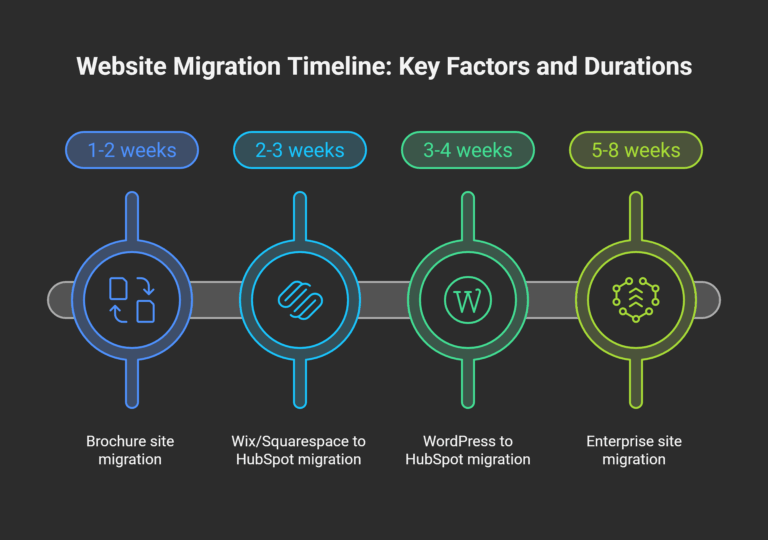If you’re asking yourself ‘how long to do website migration’ or wondering how a professional HubSpot migration service can help, you’re not alone. Many businesses consider switching platforms to enhance performance, manage content more effectively or align with growth goals. In this guide, we’ll explore realistic timelines, stages and best practices for a successful migration without delays or disruption.
Understanding Website Migration: What’s Involved?
Before exploring the timeline of a website migration, it’s essential to first understand what the process involves. Website migration typically means transferring the content, structure, data and features of a website from one platform to a different one.
In a typical HubSpot migration, the scope includes:
-
Content migration (blogs, pages, images, media)
-
URL mapping and redirects
-
Template recreation or redesign
-
CMS setup and configuration
-
SEO optimization and testing
So, How Long to Do Website Migration Take?
Let’s get straight to the point: a standard website migration usually takes between 2 to 8 weeks, depending on several factors.
1. Website Size and Complexity
The larger and more complex your site, the longer it takes. A 10-page brochure site might take 1–2 weeks, while a 500-page enterprise site with dynamic content and multiple integrations can stretch over 6–8 weeks.
2. Platform Differences
Migration time depends on how your current CMS handles data. For example:
-
WordPress to HubSpot: typically 3–4 weeks
-
Wix or Squarespace to HubSpot: 2–3 weeks
-
Custom-built CMS to HubSpot: 5–8 weeks
3. Content Readiness
Is your content already optimized and organized? If it requires rewriting, reformatting or SEO improvements, expect additional delays.
4. Design and Functionality
Are you replicating the same design or opting for a refresh? Adding features like smart content, custom forms or integrations also adds time.
5. Team Involvement
Frequent feedback, clear communication and fast approvals accelerate timelines. Delays in sign-offs or content delivery slow everything down.

Average Timeline by Website Type
| Website Type |
Approx. Migration Duration |
| Simple (10–20 pages) |
1–2 weeks |
| Medium (20–100 pages) |
3–4 weeks |
| Large (100+ pages) |
5–8 weeks |
| eCommerce (Shopify, etc.) |
6–10 weeks |
Step-by-Step HubSpot Migration Timeline
Here’s a breakdown of how a typical HubSpot migration project is structured:
Week 1: Discovery & Audit
Week 2–3: Strategy & Mapping
-
Create sitemap & URL mapping
-
Finalize page templates and modules
-
Set up HubSpot CMS and design framework
Week 4–5: Development & Content Migration
-
Rebuild templates in HubSpot
-
Migrate blog posts, landing pages and site content
-
Implement redirects and metadata
Week 6: Testing & QA
-
Cross-browser and device testing
-
Validate forms, CTAs and scripts
-
Ensure all redirects and SEO tags are in place
Week 7: Launch & Post-Migration Audit

How a HubSpot Website Migration Helps Reduce Time and Risk
Without expert support, website migrations can stretch into months and risk serious SEO drops. A specialized HubSpot migration ensures:
-
Faster execution due to proven processes
-
Fewer errors and missed redirects
-
Stronger SEO continuity
-
Clear communication and project management
-
Built-in QA and performance checks
Having led dozens of migrations over the past 15 years, I’ve seen firsthand how experienced teams can shave weeks off a project and help businesses avoid traffic losses.
Common Mistakes That Delay Website Migrations
Avoid these pitfalls to stay on schedule:
-
Starting without a clear sitemap or redirect strategy
-
Overcomplicating the design during migration
-
Waiting too long for stakeholder approvals
-
Forgetting to optimize images and on-page SEO
-
Skipping testing or launch prep
Each of these can push your timeline out by days or even weeks.
Conclusion
So, how long to do website migration take? The duration varies based on your objectives, the amount of content, design requirements and the content management system (CMS) you’re switching to. With the right strategy and a skilled HubSpot website migration, you can expect:
The key is preparation, communication and expert execution. At Mpire Solutions, we provide end-to-end HubSpot migration that deliver results—on time and on strategy.
FAQs
Q1: Will migrating my website hurt my SEO?
Only if done incorrectly. With proper redirects, metadata preservation and SEO benchmarking, you can maintain or even improve your rankings.
Q2: Can I migrate my site myself?
You can but the learning curve is steep. For most businesses, working with a HubSpot consultant saves time and prevents critical mistakes.
Q3: What’s the best time to launch a migrated site?
During off-peak hours or weekends. This minimizes disruption and gives your team space to fix post-launch issues.
Q4: Is HubSpot CMS good for SEO?
Yes. HubSpot’s CMS is built with SEO in mind and offers integrated tools to manage on-page SEO, redirects and performance tracking.
Q5: How much does a HubSpot migration cost?
Pricing depends on site size, complexity and custom development. Small migrations may start around $2,500, while larger ones can exceed $10,000.
Relevant Guides & Services
How to Integrate HubSpot with Shopify – Step by Step Guide
Does HubSpot Integrate with Shopify? A Complete Guide for E-commerce Marketers
HubSpot Marketing Email SPF and DMARC – Updated Guide 2025
How to Create a Deal in HubSpot – Beginners Guide
Why Businesses Overpay for Cloud Services and How to Fix It
How to Change Marketing Contact Status in HubSpot – 1 Min Guide
 HubSpot Consulting Needs
HubSpot Consulting Needs  Custom Automation Plan
Custom Automation Plan 







